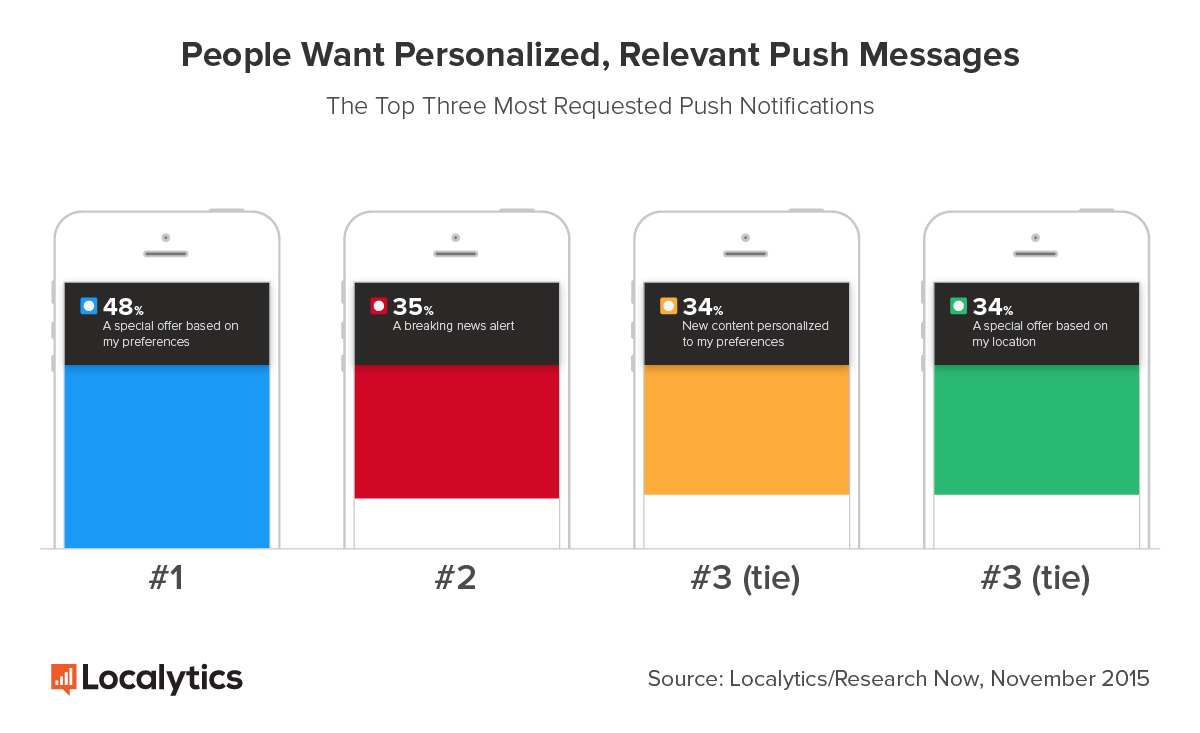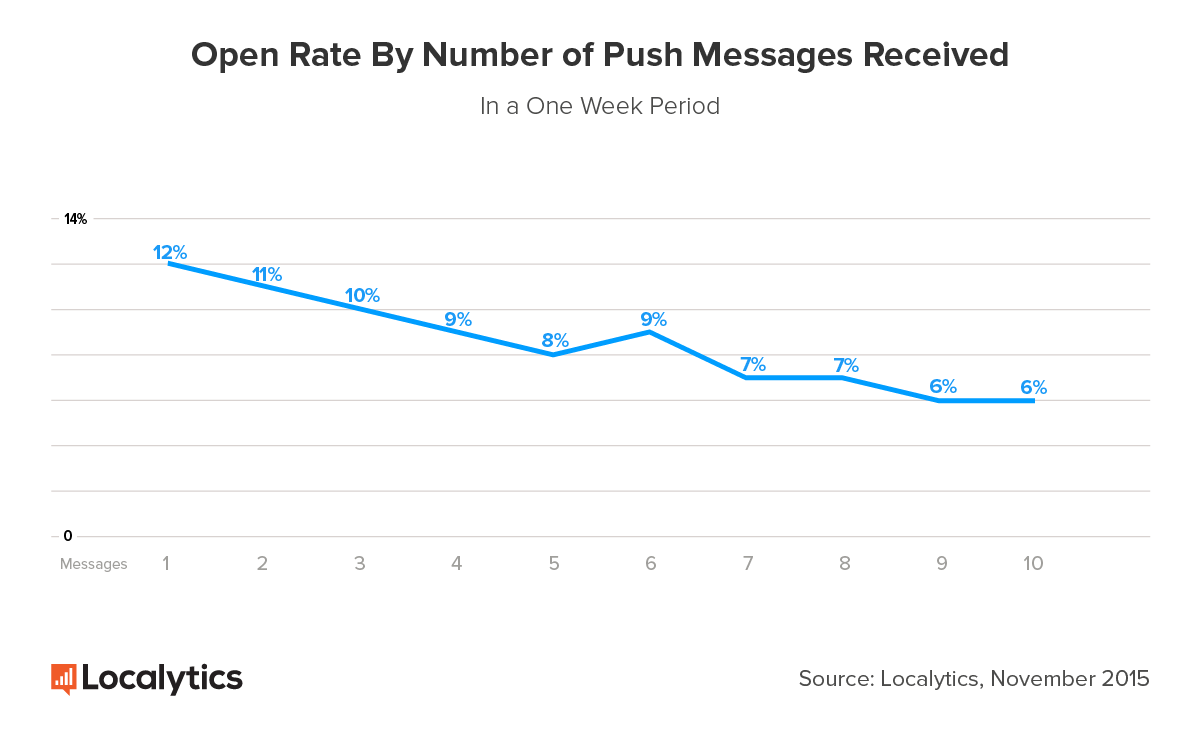Our 2015 push report proves push notifications have a dramatic effect on an app’s ability to engage users. But, as marketers, it’s our responsibility to use push messaging wisely and make sure that it does not go the way of email spam.
With that in mind, we wanted to know: What do smartphone users think about push notifications?
To get the inside view, we conducted a survey in partnership with Research Now to get in the heads of app users. The results provide an eye-opening view into how people actually feel about push notifications.
Over 50% of app users find push notifications annoying
Over half of the survey respondents found push messages to be “an annoying distraction,” which is not a surprise. Push messages have a reputation for being unwelcome. When you consider the fact that over 35% of push notifications are generic “broadcast” blasts to all users, it’s easy to see that a lack of relevancy plays a major role in this perception.

Sending the same push message to every user should not be part of an app’s marketing strategy, especially considering our last post proved that personalized push is a better strategy than broadcast marketing. For instance, there is a 3X improvement in conversion rates when push notifications are personalized to user preferences.
It all starts here: in order to better serve users and not have push messages be seen as annoying, companies need to make a better effort to learn more about their mobile users.
This means collecting both customer profile and behavioral data to inform personalized push content. It also means testing and optimizing for important factors, like the volume and send time of messages, to find out when users are most receptive. When data is used to inform smart push engagement strategies, the mindset of users is quite different, as we’ll see next.
But the other 50% of users find push notifications helpful
When it comes to how people feel about push notifications, there are two sides to the coin. The other half of the survey respondents found push messages to be helpful – either because the messages alert users to things they are interested in or because the content provides valuable information.
So how do companies make sure the viewpoint that push notifications are helpful becomes the norm? The first step is to stop treating push notifications as an extension of email. Mobile marketing requires its own rules and strategies. Mobile requires personalization, on a scale that isn’t possible on the web, so it should be no surprise that consumers want MORE personalization.
The most requested type of push notification? A personalized one
When we asked survey respondents what they actually wanted from push messages, the top three responses all had one common theme: personalization. Personalization can come in many different forms, and it’s all dependent on how well companies know their users. Personalized content can be a user’s favorite sports teams, a pair of shoes they looked at on the app, or their physical location.
 Whether users want to receive a push message about new content or a location based alert, they want it to be for something they are interested in. This ties into the idea that companies need to get to know their users even better, because it shows that a deep knowledge about what app users want will help to create a meaningful push message that makes them return to the app.
Whether users want to receive a push message about new content or a location based alert, they want it to be for something they are interested in. This ties into the idea that companies need to get to know their users even better, because it shows that a deep knowledge about what app users want will help to create a meaningful push message that makes them return to the app.
How many push notifications are too many?
A common way to turn users off from push messages is to send them too many. It’s difficult to pinpoint the exact threshold, but consumers lean towards the fewer the better. According to the survey, receiving between 2 and 5 messages in one week would cause 46% of respondents to disable push notifications. 32% of respondents said they would stop using the app altogether if they received between 6 and 10 messages in a week’s time.
 When we looked across our own user base at the number of sent push messages to identify the threshold – the point at which too many are too many – we also could not pinpoint an exact number. But our data did show a strong negative correlation between open rates and sending multiple messages in one week, proving the theory that the more messages a company sends, the higher risk for losing their users.
When we looked across our own user base at the number of sent push messages to identify the threshold – the point at which too many are too many – we also could not pinpoint an exact number. But our data did show a strong negative correlation between open rates and sending multiple messages in one week, proving the theory that the more messages a company sends, the higher risk for losing their users.
 It is important to not bombard the user with push messages, so it is vital for an app to determine the threshold that best suits their users. Apps should keep tabs on how their users are responding to both the amount and the content of the messages.
It is important to not bombard the user with push messages, so it is vital for an app to determine the threshold that best suits their users. Apps should keep tabs on how their users are responding to both the amount and the content of the messages.
Measurement should go beyond typical campaign metrics, like conversion rates, to include long term business metrics, like a push notification campaign’s effect on app user retention. That way marketers will definitely know what it takes to best serve consumers, and grow their apps.
Push messages have come a long way in recent years, but this data shows there is still work to be done in order to better align a company’s messaging strategy with what consumers actually want. With that in mind, make sure to tune into our next post where we’ll divulge the critical best practices for crafting mobile engagement campaigns with push notifications.
Methodology
Localytics is the leading mobile engagement platform across more than 2.7 billion devices and 37,000 mobile and web apps. Localytics processes 120 billion data points monthly. For this analysis, Localytics partnered with Research Now to survey 1,000 smartphone users. Previously released findings can also be found here. For the open rate percentage analysis, we studied push messages, excluding transactional messages, for each week of November (Nov 1st-8th, Nov 9th-16th, Nov 17th-24th, Nov 25th-30th) and averaged the open rate per week for each amount of push messages sent.

